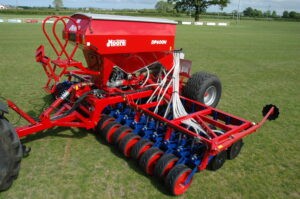
Timing and weather, as well as kit, are key parts of seedbed preparation on the min-till system.
The search for lower establishment costs has led one Warwickshire grower to ditch the plough and opt for a min-till approach that offers the capability to direct drill too. Geoff Ashcroft looks at the system in use.
The ability to direct drill cereals does hold a certain appeal, particularly when the cost savings from sowing directly into stubbles are taken into consideration.
For Warwickshire grower Andy Brown, direct drilling is an option rarely used, but is available should grain prices tumble and dictate that establishment costs need to be pared to the bone.
“There’s almost always a yield penalty from going direct, but we do have that capability up our sleeves, though we now prefer to stick with a min-till regime for most of our cropping,” says Mr Brown, who manages Spernal Farms at Great Alne, near Alcester.
With grain prices gradually heading in the right direction, his focus is currently on chasing yields rather than trimming out costs, which means direct drilling is put on the back-burner for all but 120 hectares of oilseed rape.
Cropping is 404ha of winter wheat, 120ha of oilseed rape, 120ha of herbage seed, 60ha of spring barley and 60ha of winter beans. Wheat yields are reported to be around nine tonnes /hectare and rape is averaging at 3.8t/ha when taking the min-till route. The switch to min-till on the 808 hectares of combinable crops has been gradual, as labour and machinery resources have been progressively adjusted to ensure the arable operation can remain profitable.
Just eight years ago, the farm relied heavily on a plough and power harrow-based autumn cultivations regime, choosing to run two reversible ploughs and three power harrows across the mix of red marl clays, alluvial soils and clay caps on the rolling ground occupied by Spernal Farms. Back then, Mr Brown says the entire acreage passed beneath the mouldboards before being smashed into a tilth by what he affectionately refers to as ‘powered wisks’.
Primary horsepower comes from an eight-year old JD8400, while drilling is the domain of a seven-year old Deere 7810.
There are two other tractors – a year-old JD6920s and an 8,000-hour JD6810 – which share trailer duties, but are also used for crop spraying, fertiliser spreading, rolling and hedge cutting.
With average field sizes amounting to just six hectares – accessed via Warwickshire roads – big kit is limited to the 6m hydraulically folding Moore Unidrill.
His current system is one that leads with a 3.3m Simba Solo, followed after a period of stale seedbed activity with the DP600A Unidrill, which comfortably plants 40ha/day. Just occasionally, the farm’s clay caps require an additional pass with a 5.5m Cultipress ahead of the drill, though he remains cautious not to make the ground ‘angry’ by over-working.
“We tend to rely much more on the weather and good timing to help seedbed preparation, and despite the Solo leaving a rough-looking, lumpy seedbed, it’s quite weatherproof,” he says.
“We did have a season or two with a Discordon, but it mixed trash so thoroughly and left such a good finish to the seedbed after one pass that, if it rained, the surface would pan down like concrete and we’d have to start again.
“We can’t afford to get it wrong, nor can we afford to have a surplus of high-value kit at our fingertips. But the versatility we now have, means we can direct-drill into stubbles, if grain prices dictate a cost reduction.”
The farm’s Moore drill has just completed three seasons’ use and has recently undergone a refit with new discs. Part of that longevity has come from Spernal’s stone-free soils, with the remainder attributed to min-till and the use of lighter coulter pressures.
“It was an expensive drill to buy, but has proved relatively cheap to run, though it’s not perfect,” he says.“We’ve made an additional step behind the hopper which helps when reaching forward over the longitudinal hopper when filling, and the seed tubes can become pinched in the frame when the drill is folded for transport.“But the disc coulter system, drilling depth, coulter pressure and seed placement is fantastic, regardless of seed type. We can’t afford to have two drills to deal with our crop rotation – so it really does have to be one size fits all.”
However, Mr Brown hasn’t eliminated the plough completely at Spernal Farms – 30ha is turned over each year for game cover and winter beans can be ploughed under too.
“But harvest and cultivations is no longer the frantic race against time and weather, that it once was. We have time on our hands, can make much better use of labour and machinery resources and hit target drilling dates without having to work 24-seven.”
Credit: © FARMERS GUARDIAN please contact 01772 799445.
